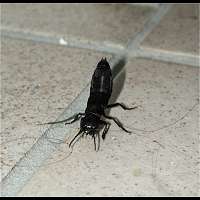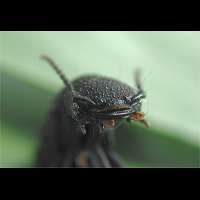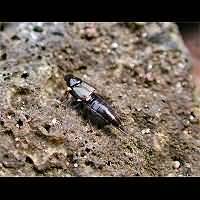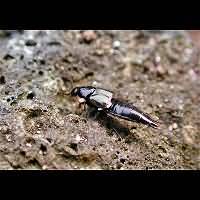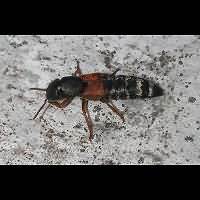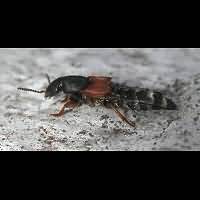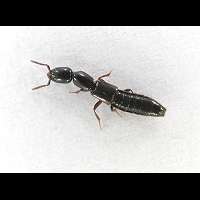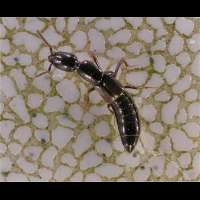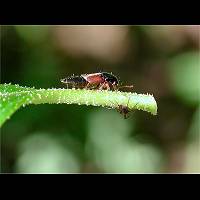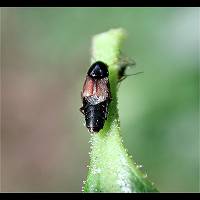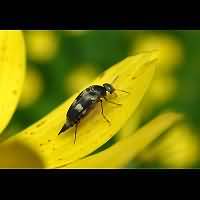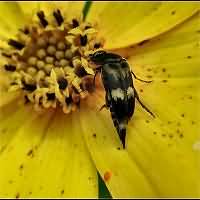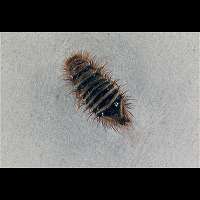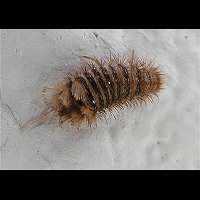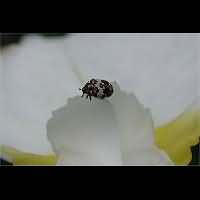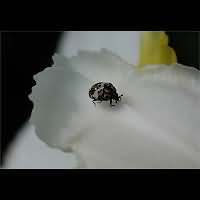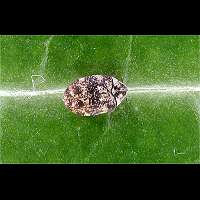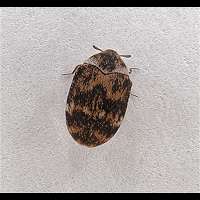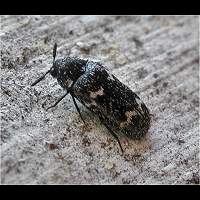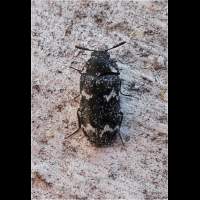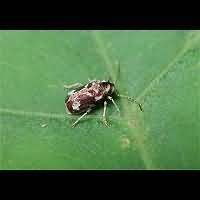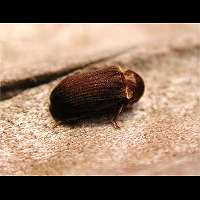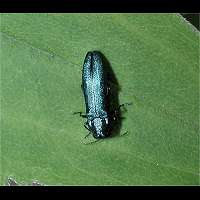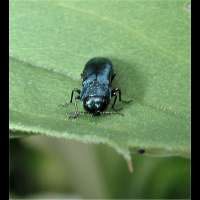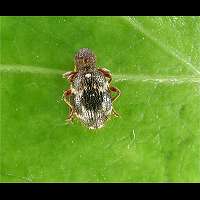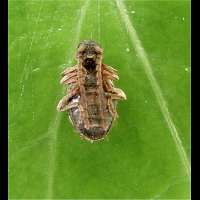[All pictures of garden wildlife on this page are thumbnails. Click on any thumbnail for a large format to be displayed.]
Small Beetles (Several families)
This is the largest group of beetles. Not closely related at all, but dealt with on this page, because they are all small to very small beetles, often very difficult to identify. Many of these very small beetles are even out of our camera's range. A few rove beetles are rather big, such as the Devil's Coach-horse, but the majority of these species, there are a few hundred of them in Central Europe, are very small.
Contents: 1 Rove Beetles, 2 Mordellidae, 3 Skin Beetles, 4 Wood-worms, 5 Jewel Beetles, 6 Spider Beetles.
![]()
1 Rove Beetles (Staphilinidae)
In Britain there are hundreds of Rove Beetle species. Actually this is the biggest group of beetles in Western Europe. All species have very short shields (elytrae), covering only up to one third of the abdomen. The wings are folded under the small shields, much the way earwigs do. Only a few species have lost the ability to fly alltogether. Most species are small, but a few are quite big and behave baldly feeling threatened. Best known is the Devil's Coach Horse. A very common species, often found in gardens. Especially in autumn it is regularly found indoors, usually causing panic, fear and amazement. When approached it will lift its head and curl up its abdomen. This makes it look like a very small scorpion. It's his defense position: he's ready to attack. It has big, powerful jaws, easily capable of penetrating the human skin to deliver a painful bite and it won't let go quickly. And on the curled abdomen are two glands producing a very nasty smelling stuff it sprays into your direction. Still consider this a very welcome guest in your garden though, for it eats a lot of snails. Measuring up to 33 mm this is the biggest of all European Rove Beetles. A very common species all over the British Isles, including the Shetlands.
Our biggest Rove Beetle, the Devil's Coach Horse (Staphylinus olens), has the head of an alien...
There are only a few big Rove Beetles. The majority is smalller than 1 centimetre and a very large group even is below 5 mm. Many Rove Beetles are predators, hunting for insects and their larvae, snails, slugs and springtails. Many species live in or near muck or cadavers. Others are scavengers. The beautiful Rove Beetle below is a member of the genus Philothus, according to both: Guido Bonamie en Boris Büche. It is not possible to tell the exact species from a photograph. Philonthus species are very common in most gardens.
This is a rove beetle (Philonthus sp.)
Thanks to Arie M. den Toom, Guido Bonamie and especially Boris Büche we now know the scientific name of the beetle below. It is called Platydracus stercorarius and is a very common small rove beetle. By the way: in the past it was known as Staphylinus stercorarius. It seems to run around in many gardens without even bearing a common name in English.
A typical representative of the rove beetles: Platydracus stercorarius.
Many Roove Beetles are very difficult to identify. Take the animals in the pictures below for instance. It is all black and has no real markings. So, these are Xantholinus species, but we most probably will never be able to tell which ones. This means we can't tell you any more on how it lives etc.
Two of the small Xantholinus species, which can not be told apart from pictures alone.
Alas, there are many more species which are extremely hard to identify. Take the one in the pictures below for instance. In this case the short shields are reddish brown and the real wings are just visible below them. We really have no idea about the animal's identity.
Another Roove Beetle we are unable to identify.
This is a family of tiny beetles. Apparently the family has no common English name. Their shape is very striking: the rear end has a sharply pointed ending. The species below can be found in the garden, running around on flowers. The lighter spots on the body can have all kinds of colours: white, gray, yellow or brownish. Hans van Duijnhoven identified it correctly. I did the same after Guido pointing out to me the right family. This species is scientifically also known as Mordella fasciata.
This very small beetle is called Variimorda villosa.
This beetle family consists of a lot of rather small species. Many species are infamous indeed. The larvae of some species live in warehouses, being able to destroy the goods in a very short time, while the larvae of some other species live of dead organic material, such as hairs and other fibers. Take the Museum Beetle for instance. It not only appreciates dead insects in nature, but the ones in museums and other collections as well. Another group of notorious beetles in this family is comprised of the Carpet Beetles. In nature however they clean up old bird's nests etc, just like the caterpillars of some of the House Moths do. The larvae of Skin Beetles are curiously shaped creatures though.
These are the curiously shaped larvae of Skin Beetles, probably genus Anthrenus.
Most of the species however are not dangerous at all. The adults of most species can be found on flowers regularly, eating nectar and pollen. One has to look careful though: most species are between one and four millimeters only! Identifying them is very difficult indeed, for not only are they very small, they also do look like one another very much and many species are extremely variable. The identification below is a tentative one.
This is a relative of the Museum Beetle: probably Anthrenus pimpinellae.
Below the notorious Varied Carpet Beetle, also known as the Variegated Carpet Beetle or Museum Beetle. It is a very small beetle (1 to 3 mm long only) with a highly variable pattern of yellowish and whitish markings. It can be found all year round, both inside the house and outside. Has been transported by humans with leather, wool and textile and is nowadays to be found all over the world. The larvae live of all kinds of dead natural stuff, such as wool, feathers etc. In nature it lives in old nests of birds, wasps etc. The larvae prefer dead insects though and are capable of destroying an entire insectcollection in just a few months. When you discover just a few of them in the house, there's probably no reason to be alarmed. Most probably these are just overwintering adults. When you see more than just a few, there could be a reason to be frightened. In such case you should call a licensed terminator.
The larvae of this small Varied Carpet Beetle (Anthrenus verbasci) regularly become a pest in a house, storage house or museum.
Below a much rarer species: Megatoma undata. It is a male, which you can tell by looking at the markings and the antennae. The white markings are much duller and smaller in females. Besides females have shorter and smaller antennae. The larvae feed on dead stuff, usually the remains of other insects. Not much more can be found about this species on the internet. According to some sites, mainly British, this species inhabits older forests. On some other sites, mostly German, it is a species reported to be found in the nests of bats. The species simply is not found very often. That is why it is on red lists in both England and Germany. Because of the hidden ways this creatures walks about it is very hard to say to what extend this species really is rare.
We know annoyingly little about this Megatoma undata.
This is a family of rather small and well-known beetles. Only few people actually ever see them, though. Their damage in wood, especially furniture, is notorious and the rather small holes through which the beetles leave the wood are known to almost all. This family of beetles has many common names. Woodworms is one of them, but they are also known as Deathwatch Beetles, Wood-borers, Furniture Beetles and Timber Beetles. And there is more. Not only do these animals attack wood, some species also do a lot of damage in bakeries, drugstores etc. The Drugstore Beetle, the Biscuit Beetle and the Cigarette Beetle all belong to this family. Like in most other insects the damage is done by the larvae mainly. Most adults will be happy eating some nectar from flowers, when available. In our garden we have found one species only. It is the Fan-bearing Wood-borer. One does not often come across it inside the house as the larvae prefer moist wood infested by fungae. The species prefers beech over all other trees. The so-called Furniture beetles are named after their larvae. Just like some Longhorn Beetles the larvae can live in dry, dead wood, such as... furniture. The larva of the Longhorns living in dead wood can do a lot of damage, for you don't see anything until the adult comes out of it's hole: there is no visible damage to the wood and you won't find the wood powder always seen with the small holes caused by Wood-borers. The Fan-bearing Wood-borer below to the left is a common species to be found all over Europe. Scientifically it is also referred to as Ptinomorphus imperialis. To the right a rare species found on the continent only: Anobium denticolle
Two of the many Woodworms. To the left the common Fan-bearing Wood-borer (Hedobia imperialis). Anobium denticolle to the right is not a British species.
Jewel Beetles are also referred to as Metallic Wood-boring Beetles and that name says it all. Most species have a torpado shape and short antennae. All have metallic colouring, sometimes really splendorous. They are scarce in Europe, as this is a family of tropical species mainly. In the Benelux countries one will find no more than about 30 species, many of which are very small and some are not very colourful either. Below a blue Agrilus species. Because its picture was taken in full sunlight, the pictures are not as good as we would like them to be. The larvae of some Agrilus species are among the most harmful around, able to kill adult trees in just 3 to 4 years time. The species below is called Agrilus cyanescens. It's a metallic blue beetle reaching a length of 4 to 8 mm. The larvae are often found in Honeysuckle, where the live just under the bark. Just before pupating they make a chamber inside the wood of the plant. Also libe in beech, birch, oak, bramble and roses. This is a very common species, even found in the centres of big cities. Inhabits Europe, Siberia and Northern America.
Not as beautiful as many of its family members, but still this is a Jewel Beetle: Agrilus cyanescens.
A family of small, often weirdly shaped beetles. Like the family name implies some do look like beetles, others remind you of ants. It is a very small family. Worldwide some 600 species have been found, in Central and Western Europe some 30 species have been discovered. Most species measure 5 mm tops. The antennae have 11 segments and are longer in males than in females. By the way, females and males often differ in many more respects and are often seen as separate species by mistake. Both larvae and adults can live under extremely dry circumstances. Their food is dry as well: dehydrated remains of plants and animals. Some species may become harmful chewing on precious insect collections, while others are just annoyingly present in storagehouses and stables, for even straw is favoured by some. We were unable to find good information about the species below. We do know however that it likes to fool people. After it was caught it pretended to be dead. It was absolutely motionless. We were even able to turn it around to take pictures of the underside. But when we went into the kitchen to get a drink and forgot to put a glass over the little bugger, it was gone by the time we returned. We never saw it again... The scientific name Bruchoptinus rufipes is also used for this species.
We were unable to find much information on this small Spider Beetle, which pretended to be dead: Ptinus rufipes.

© Copyright 1998-2024 gardensafari.net (Hania Berdys)

 English / engels
English / engels  Dutch / nederlands
Dutch / nederlands